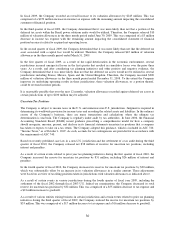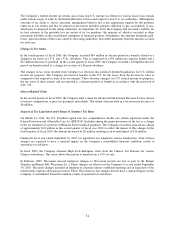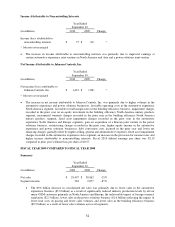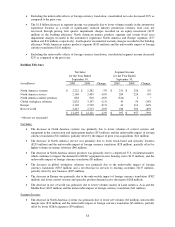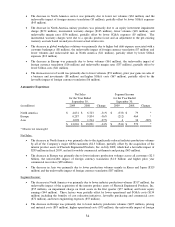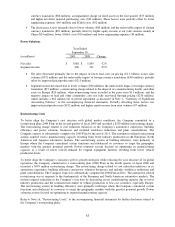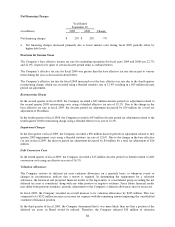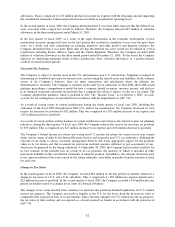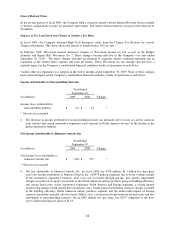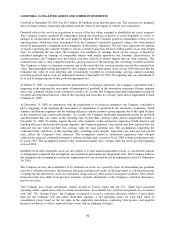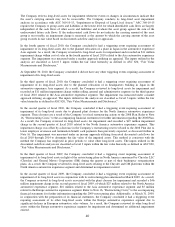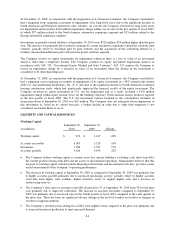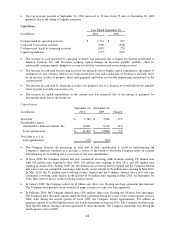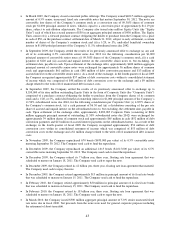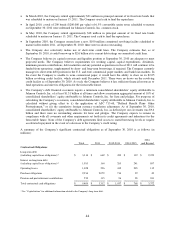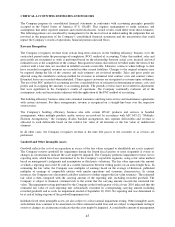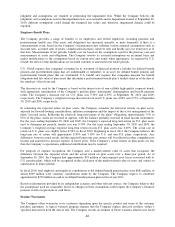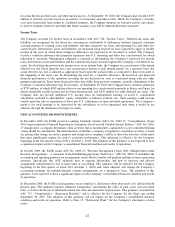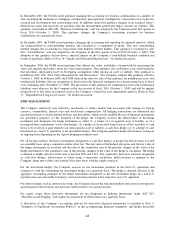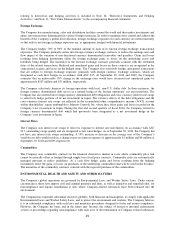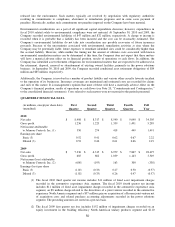Johnson Controls 2010 Annual Report Download - page 40
Download and view the complete annual report
Please find page 40 of the 2010 Johnson Controls annual report below. You can navigate through the pages in the report by either clicking on the pages listed below, or by using the keyword search tool below to find specific information within the annual report.40
The Company reviews long-lived assets for impairment whenever events or changes in circumstances indicate that
the asset’s carrying amount may not be recoverable. The Company conducts its long-lived asset impairment
analyses in accordance with ASC 360-10-15, ―Impairment or Disposal of Long-Lived Assets.‖ ASC 360-10-15
requires the Company to group assets and liabilities at the lowest level for which identifiable cash flows are largely
independent of the cash flows of other assets and liabilities and evaluate the asset group against the sum of the
undiscounted future cash flows. If the undiscounted cash flows do not indicate the carrying amount of the asset
group is recoverable, an impairment charge is measured as the amount by which the carrying amount of the asset
group exceeds its fair value based on discounted cash flow analysis or appraisals.
In the fourth quarter of fiscal 2010, the Company concluded it had a triggering event requiring assessment of
impairment of its long-lived assets due to the planned relocation of a plant in Japan in the automotive experience
Asia segment. As a result, the Company reviewed its long-lived assets for impairment and recorded an $11 million
impairment charge within cost of sales in the fourth quarter of fiscal 2010 related to the Asia automotive experience
segment. The impairment was measured under a market approach utilizing an appraisal. The inputs utilized in the
analysis are classified as Level 3 inputs within the fair value hierarchy as defined in ASC 820, ―Fair Value
Measurements and Disclosures.‖
At September 30, 2010, the Company concluded it did not have any other triggering events requiring assessment of
impairment of its long-lived assets.
In the third quarter of fiscal 2010, the Company concluded it had a triggering event requiring assessment of
impairment of its long-lived assets due to the planned relocation of its headquarters building in Japan in the
automotive experience Asia segment. As a result, the Company reviewed its long-lived assets for impairment and
recorded an $11 million impairment charge within selling, general and administrative expenses in the third quarter
of fiscal 2010 related to the Asia automotive experience segment. The impairment was measured under a market
approach utilizing an appraisal. The inputs utilized in the analysis are classified as Level 3 inputs within the fair
value hierarchy as defined in ASC 820, ―Fair Value Measurements and Disclosures.‖
In the second quarter of fiscal 2010, the Company concluded it had a triggering event requiring assessment of
impairment of its long-lived assets due to planned plant closures for the North America automotive experience
segment. These closures are a result of the Company’s revised restructuring actions to the 2008 Plan. Refer to Note
16, ―Restructuring Costs,‖ to the accompanying financial statements for further information regarding the 2008 Plan.
As a result, the Company reviewed its long-lived assets for impairment and recorded a $19 million impairment
charge in the second quarter of fiscal 2010 related to the North America automotive experience segment. This
impairment charge was offset by a decrease in the Company’s restructuring reserve related to the 2008 Plan due to
lower employee severance and termination benefit cash payments than previously expected, as discussed further in
Note 16. The impairment was measured under an income approach utilizing forecasted discounted cash flows for
fiscal 2010 through 2014 to determine the fair value of the impaired assets. This method is consistent with the
method the Company has employed in prior periods to value other long-lived assets. The inputs utilized in the
discounted cash flow analysis are classified as Level 3 inputs within the fair value hierarchy as defined in ASC 820,
―Fair Value Measurements and Disclosures.‖
In the third quarter of fiscal 2009, the Company concluded it had a triggering event requiring assessment of
impairment of its long-lived assets in light of the restructuring plans in North America announced by Chrysler LLC
(Chrysler) and General Motors Corporation (GM) during the quarter as part of their bankruptcy reorganization
plans. As a result, the Company reviewed its long-lived assets relating to the Chrysler and GM platforms within the
North America automotive experience segment and determined no impairment existed.
In the second quarter of fiscal 2009, the Company concluded it had a triggering event requiring assessment of
impairment of its long-lived assets in conjunction with its restructuring plan announced in March 2009. As a result,
the Company reviewed its long-lived assets associated with the plant closures for impairment and recorded a $46
million impairment charge in the second quarter of fiscal 2009, of which $25 million related to the North America
automotive experience segment, $16 million related to the Asia automotive experience segment and $5 million
related to the Europe automotive experience segment. Refer to Note 16, ―Restructuring Costs,‖ to the accompanying
financial statements for further information regarding the 2009 restructuring plan. Additionally, at March 31, 2009,
in conjunction with the preparation of its financial statements, the Company concluded it had a triggering event
requiring assessment of its other long-lived assets within the Europe automotive experience segment due to
significant declines in European automotive sales volume. As a result, the Company reviewed its other long-lived
assets within the Europe automotive experience segment for impairment and determined no additional impairment
existed.


